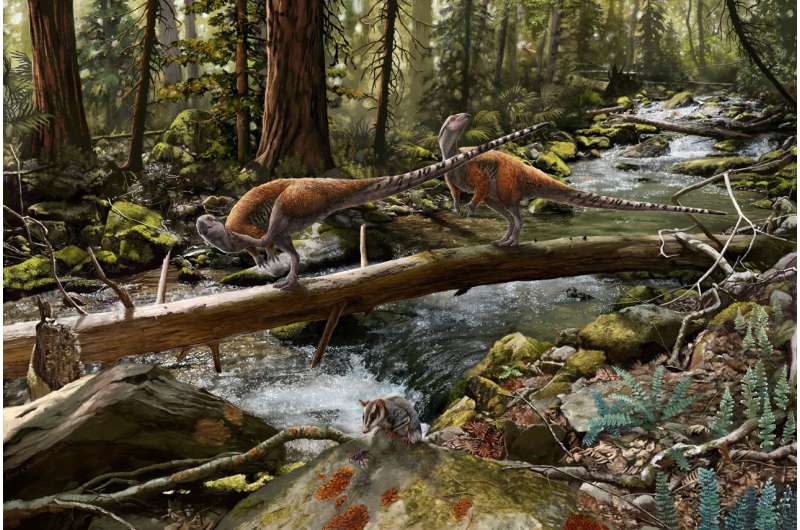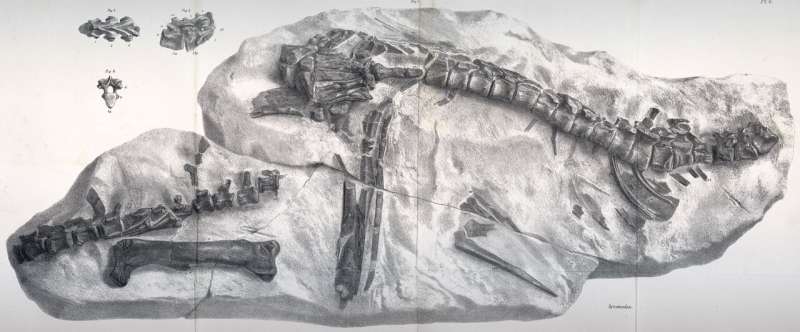This article has been reviewed according to Science X's editorial process and policies. Editors have highlighted the following attributes while ensuring the content's credibility:
fact-checked
peer-reviewed publication
trusted source
proofread
Isle of Wight fossil suggests Europe had its own family of small herbivorous dinosaurs

Scientists have discovered a new species of small plant-eating dinosaur on the Isle of Wight in southern England (UK). The new species, Vectidromeus insularis, is the second member of the hypsilophodont family to be found on the island, suggesting that Europe had its own family of small herbivorous dinosaurs, distinct from those found in Asia and North America.
Hypsilophodonts were a group of nimble, bipedal herbivores that lived around 125 million years ago. The animals lived alongside early tyrannosaurs, spinosaurs, and Iguanodon. The new fossil represents an animal about the size of a chicken but was a juvenile and may have grown much larger.
Vectidromeus is a close relative of Hypsilophodon foxii, a dinosaur originally described in the Victorian era, and one of the first dinosaurs to be described from relatively complete remains. Small and with gracile, with bird-like hindlimbs, hypsilophodonts were used by famous scientist Thomas Henry Huxley as evidence that birds were related to dinosaurs.
Hypsilophodon is also found on the Isle of Wight, but was found higher up in the rocks, perhaps two or three million years younger than Vectidromeus. Vectidromeus differs in details of the hip bones, suggesting it's a closely related but distinct species.
Dr. Nicholas Longrich, from the Milner Center for Evolution at the University of Bath, led the study. He said, "Paleontologists have been working on the Isle of Wight for more than a century, and these fossils have played an important role in the history of vertebrate paleontology, but we're still making new discoveries about the dinosaur fauna as the sea erodes new fossils out of the cliffs."
The Cretaceous strata on the Isle of Wight are hundreds of meters thick and may span several million years—scientific consensus is still not entirely clear how old they are—so the fossils may be sampling a whole series of evolving ecosystems, each with a different set of species.
The discovery was made as part of a collaboration led by the University of Bath, along with the University of Portsmouth, the Isle of Wight Dinosaur Museum in Sandown, and local fossil collectors.
"Working with the amateur community is really important," said Longrich. "It's good to have a diverse team; everyone brings something different to the table. These guys have spent their lives collecting and preparing these fossils, they know details about the rock, the geology, and the bone that nobody else does. Everyone sees different pieces of the puzzle."
Co-author on the study Professor Dave Martill from the University of Portsmouth said, "It is utterly bizarre that so many new dinosaurs are being discovered on the Isle of Wight.
"Vectidromeus is the seventh new species of dinosaur to be discovered in the last four years. This is all down to the amateur collectors."
Over the years, dozens of small plant-eating dinosaurs have been put into the hypsilophodont family, but revisions to the dinosaur family tree have resulted in reclassifying them to other branches of the tree, leaving Hypsilophodon as the only species left in the family.
Dr. Longrich said, "We had a curious situation where one of the first dinosaur families to be recognized had just one species. And now, we have two.
"What's intriguing is that they're not particularly closely related to anything found in North America, Asia, or the southern hemisphere.

"We're still piecing together how all these dinosaurs are related, and how dinosaurs moved between continents. After Pangaea broke up, there was a lot of isolation, leading to different kinds of dinosaurs evolving on each continent."
Co-author, and curator of Dinosaur Isle Museum Dr. Martin Munt said, "This exciting new find is the latest in a line of new discoveries from the Isle of Wight.
"We are enjoying an amazing time of collaboration between collectors, researchers and the museum. New finds are being made on the coast, in private collections, and the museum stores.
"The museum's mission is to try and ensure as many new finds remain here on the island for the benefit of our Island community; we anticipate this dinosaur to be on display at the museum for the October school holidays."
The findings are published in the journal Cretaceous Research.
More information: Nicholas R. Longrich et al, Vectidromeus insularis, a new hypsilophodontid dinosaur from the Lower Cretaceous Wessex Formation of the Isle of Wight, England, Cretaceous Research (2023). DOI: 10.1016/j.cretres.2023.105707
Journal information: Cretaceous Research
Provided by University of Bath





















